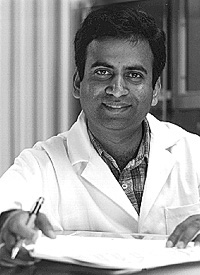Our Science – Sharan Website
Shyam K. Sharan, Ph.D.
 |
|
|||||||||||||||||||||||||
Biography
Dr. Sharan obtained his B.Sc. in botany and M.Sc. in genetics from Delhi University, Delhi. In 1994, he obtained his Ph.D. in genetics under Dr. Terry Magnuson at Case Western Reserve University. He then joined Dr. Allan Bradley's laboratory at Baylor College of Medicine as a Howard Hughes Medical Institute Associate. In 1998, Dr. Sharan established the Genetics of Cancer Susceptibility Group in the ABL-Basic Research Program. His group is involved in the functional analysis of tumor suppressor genes in mice. In 1999, Dr. Sharan joined the Center for Cancer Research, NCI.
Research
Breast cancer is the most common malignancy in women. Mutations in BRCA1 and BRCA2 genes play an important role in the development of early-onset familial breast cancer. Our goal is to carry out functional dissection of these genes using a mouse model system. Since complete loss of function mutations result in embryonic lethality, we are engaged in generating an array of specific mutations along the length of proteins encoded by these genes. To accomplish this, we have developed a transgenic mouse model system that combines the use of existing Brca1 and Brca2 knockout mice and the use of bacterial artificial chromosomes (BAC) containing these genes. Desired mutations can be generated in the Brca1 or Brca2 gene in the BAC and the phenotypic effect of the mutation can be analyzed in transgenic mice that are homozygous mutant for that gene. In a continuing effort to understand the role of BRCA1 and BRCA2 in various biological processes, we have developed humanized mouse models for functional analysis of human BRCA1 and BRCA2 genes. We have shown that wild-type human BRCA1 and the BRCA2 genes under the control of their own promoter present in BAC clones are fully functional in mice and can rescue the lethality associated with loss of function mutations of the respective genes in mice. The humanized mouse models provide an experimentally tractable system to generate mutations identified in human breast cancer patients and analyze how they result in tumorigenesis.
We have developed a simple but powerful method to generate subtle alterations in the BACs by using recombineering in bacteria. This method is based on the generation of recombinants in the BAC DNA by using oligonucleotides as targeting vectors with as few as 70 bases of homology. We have demonstrated that this technique can be used to generate single base changes, small insertions and deletions. Due to the high efficiency of recombineering, recombinant clones can be identified by a simple PCR based screening method without the use of any selectable marker. We have used this method to generate several cancer causing missense mutations in BRCA1 and BRCA2 in the BAC and are examining their phenotypic consequences in mice in a Brca1 or Brca2 mutant background.
Based on the expression of BRCA2 on meiotic chromosomes, it has been predicted to be required for normal meiotic progression. Due to the embryonic lethality of Brca2 null mice, the precise function of BRCA2 protein in meiosis is unknown. We have generated a mouse model to describe a role for BRCA2 in meiosis. These mice lack the endogenous Brca2 gene but lethality is rescued by a human BRCA2 transgene. However, these mice are sterile due to poor expression of the transgene in testes and ovaries. We have used these mice to describe a role for BRCA2 in meiosis that is sexually dimorphic. We have found that the BRCA2-deficient spermatocytes undergo apoptosis unlike the BRCA2-deficient breast and ovarian epithelial cells that undergo neoplastic growth. This suggests that the cellular response to DNA damage may be tissue specific, which may explain why mutations in this widely expressed gene do not result in cancer in all tissues.
Although transgenic humanized mice using BACs are excellent in vivo models for understanding the functional significance of the human mutations, they are not ideally suited for characterizing large number of mutations. Hence, we are developing an embryonic stem (ES) cell-based functional assay to rapidly screen large number of mutations. The assay is based on the observation that mouse ES cells that are mutated in both alleles of either Brca1 or Brca2 genes, do not survive. We intend to use this assay system to study large number of mutations in a short time by testing their ability to rescue the ES cell lethality. Those mutations that can rescue the lethality will be examined for defects in various DNA repair processes. As a future goal, we plan to identify genes that genetically interact with BRCA1 or BRCA2 by undertaking an insertional mutagenesis approach in ES cells. By using retroviral insertion to activate genes, we will identify genes that can rescue the lethality of the BRCA1 or BRCA2-deficent ES cells. Such genes might provide insight into why some cells undergo apoptosis in the absence of these proteins while others continue to proliferate. We have also initiated the functional analysis of Rad51l2, a member of the Rad51-like family. Rad51 is one of the key DNA repair protein that interacts with both BRCA1 and BRCA2. We plan to determine whether RAD51L2 interacts with BRCA1 or BRCA2 proteins as in vitro studies have demonstrated a role for RAD51L2 in homologous DNA repair.
The long-term objective of my group is to comprehensively delineate the biological function of BRCA1 and BRCA2. In doing so we will understand how the mutations that are scattered throughout the length of these genes lead to cancer. It is our hope that such an understanding will lead to identification of potential targets and the design of inhibitors that would either retard or completely inhibit the aberrant path towards carcinogenesis.
This page was last updated on 1/7/2009.

